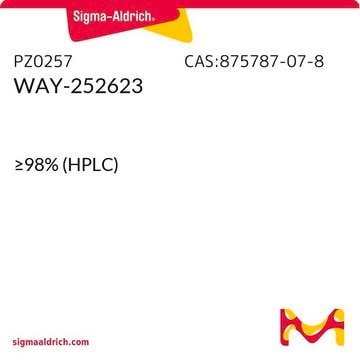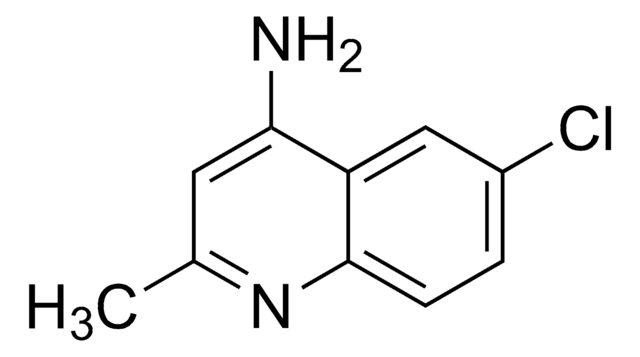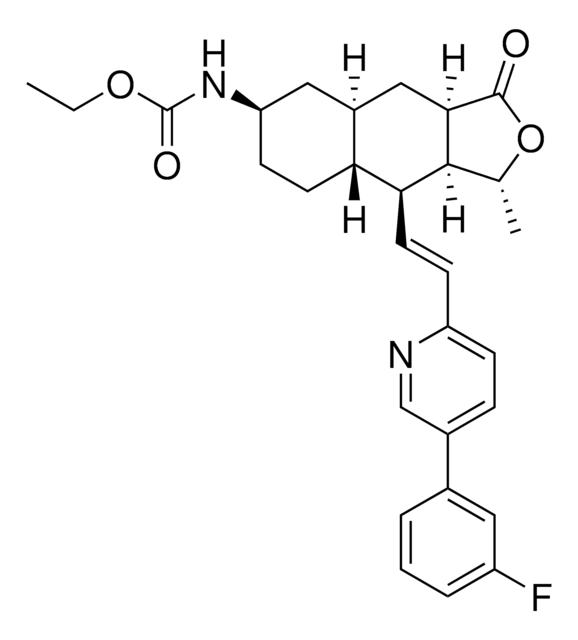PZ0115
CP-31398 dihydrochloride hydrate
≥98% (HPLC)
Sinónimos:
N′-[2-[2-(4-Methoxyphenyl)ethenyl]-4-quinazolinyl]-N,N-dimethyl-1,3-propanediamine dihydrochloride hydrate
About This Item
Productos recomendados
assay
≥98% (HPLC)
storage condition
desiccated
color
yellow
solubility
H2O: ≥20 mg/mL
storage temp.
2-8°C
SMILES string
O.Cl.Cl.COc1ccc(cc1)\C=C\c2nc(NCCCN(C)C)c3ccccc3n2
InChI
1S/C22H26N4O.2ClH.H2O/c1-26(2)16-6-15-23-22-19-7-4-5-8-20(19)24-21(25-22)14-11-17-9-12-18(27-3)13-10-17;;;/h4-5,7-14H,6,15-16H2,1-3H3,(H,23,24,25);2*1H;1H2/b14-11+;;;
InChI key
JXIVIAMOMIONKY-UWCBQFGESA-N
Gene Information
human ... TP53(7157)
mouse ... TP53(22059)
rat ... TP53(24842)
Application
- to evaluate its effects on the upregulation of miRNA in human neuroblastoma cells
- to study its effects on arsenic trioxide (ATO) stabilization of p53 folding
- to study its effects on regulation of miR-34 in PC12 cells
Biochem/physiol Actions
Features and Benefits
signalword
Warning
hcodes
Hazard Classifications
Acute Tox. 4 Oral - Aquatic Chronic 4 - Eye Irrit. 2 - Skin Irrit. 2
Storage Class
11 - Combustible Solids
wgk_germany
WGK 3
flash_point_f
Not applicable
flash_point_c
Not applicable
Certificados de análisis (COA)
Busque Certificados de análisis (COA) introduciendo el número de lote del producto. Los números de lote se encuentran en la etiqueta del producto después de las palabras «Lot» o «Batch»
¿Ya tiene este producto?
Encuentre la documentación para los productos que ha comprado recientemente en la Biblioteca de documentos.
Artículos
Cell cycle phases (G1, S, G2, M) regulate cell growth, DNA replication, and division in proliferating cells.
Apoptosis regulation involves multiple pathways and molecules for cellular homeostasis.
Nuestro equipo de científicos tiene experiencia en todas las áreas de investigación: Ciencias de la vida, Ciencia de los materiales, Síntesis química, Cromatografía, Analítica y muchas otras.
Póngase en contacto con el Servicio técnico![[Pyr1]-Apelin-13 trifluoroacetate salt ≥96% (HPLC)](/deepweb/assets/sigmaaldrich/product/images/391/809/a864cd5a-3260-42cf-93ae-cb4754f4e4ad/640/a864cd5a-3260-42cf-93ae-cb4754f4e4ad.jpg)









